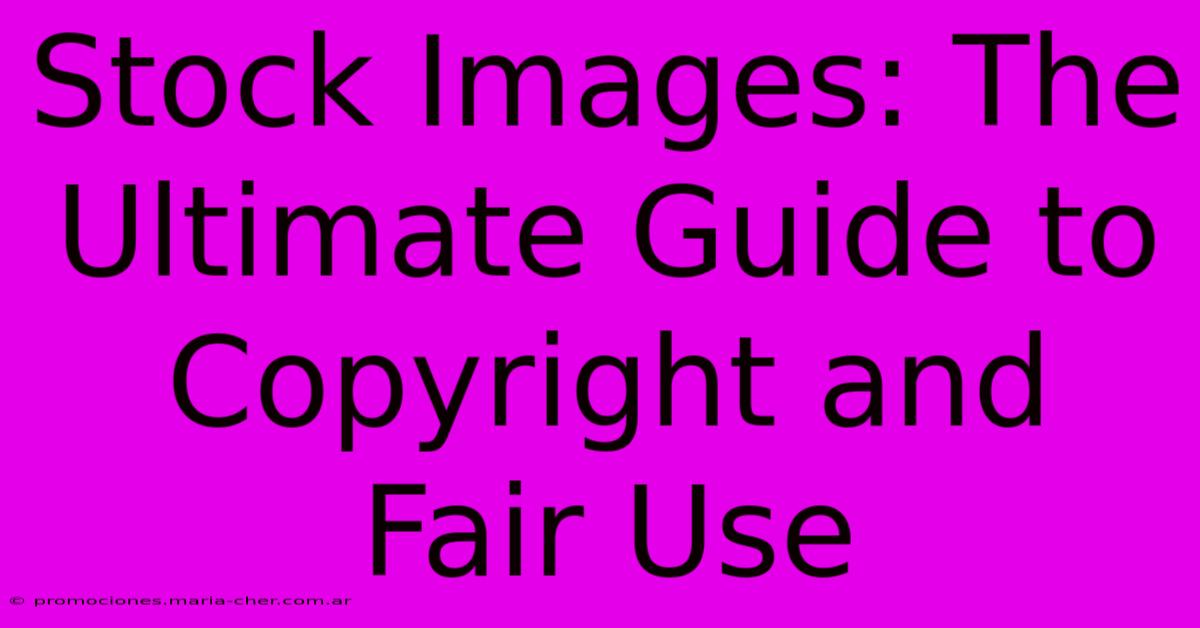Stock Images: The Ultimate Guide To Copyright And Fair Use

Table of Contents
Stock Images: The Ultimate Guide to Copyright and Fair Use
Using stock images can be a game-changer for your website, blog, or marketing materials. They add visual appeal, professionalism, and can save you significant time and money compared to hiring a professional photographer. However, navigating the copyright and fair use landscape of stock photography is crucial to avoid legal trouble and hefty fines. This ultimate guide will equip you with the knowledge to use stock images responsibly and legally.
Understanding Copyright and Stock Photos
Every image created is automatically protected by copyright. This means the creator (photographer) owns the exclusive rights to reproduce, distribute, display, and create derivative works from their image. Stock photo websites act as intermediaries, licensing these images to users, not transferring ownership. This means you're paying for a license to use the image, not outright ownership.
Types of Stock Photo Licenses:
Several license types exist, each with varying degrees of usage restrictions. The most common are:
-
Royalty-Free Licenses: These are the most prevalent. You pay a one-time fee for the right to use the image, usually with limitations on the scale of use (e.g., website use versus large-scale print campaigns). The name is a bit misleading; you aren't necessarily free from all royalties; restrictions apply, usually dictated in the license agreement.
-
Rights-Managed Licenses: These licenses are typically more expensive and offer greater control over how the image is used. They often involve negotiating usage rights on a per-project basis. This type of license is usually reserved for major publications or commercial projects requiring extensive usage.
-
Creative Commons Licenses: These are public copyright licenses that offer a range of usage rights, from free use with attribution to more restrictive conditions. Always carefully check the specific terms of a Creative Commons license before using an image.
Navigating Fair Use
Fair use is a legal doctrine that permits limited use of copyrighted material without obtaining permission. However, fair use is a complex area of law with no easy answers. It's usually judged on a case-by-case basis, considering four factors:
- The purpose and character of your use: Is the use transformative (adding new meaning or message)? Non-commercial use is more likely to be considered fair use.
- The nature of the copyrighted work: Using a factual image is more likely to be deemed fair use than using a highly creative or artistic image.
- The amount and substantiality of the portion used: Using a small portion of the image is more likely to be considered fair use than using the entire image.
- The effect of the use upon the potential market for or value of the copyrighted work: Does your use harm the market for the original image?
Important Note: Even if you believe your use falls under fair use, it's still risky. Successfully arguing fair use in court can be costly and time-consuming. The safest approach is to obtain the necessary license.
Choosing and Using Stock Images Legally
To avoid copyright infringement, always follow these steps:
- Check the License: Before using any image, carefully review the license agreement provided by the stock photo website. Understand the permitted uses, restrictions, and attribution requirements.
- Proper Attribution: If the license requires attribution, provide it accurately and conspicuously. This usually involves linking back to the photographer or the stock photo website.
- Use Reputable Websites: Choose reputable stock photo websites that clearly display licensing information and ensure a secure transaction process.
- Keep Records: Maintain records of your stock image purchases and licenses. This will be vital if any copyright disputes arise.
- Avoid Infringement: Don't download or use images from websites that don't clearly state their licensing terms. Don't modify images to such an extent that your use no longer complies with the license terms.
Conclusion: Playing it Safe with Stock Images
Using stock images is a powerful way to enhance your content, but respecting copyright and understanding fair use are non-negotiable. Prioritizing legal compliance not only safeguards you from legal action but also ensures ethical and responsible use of creative works. Always obtain the appropriate license and adhere to its terms. By understanding the nuances of copyright and licenses, you can confidently leverage the visual power of stock photography without jeopardizing your project.

Thank you for visiting our website wich cover about Stock Images: The Ultimate Guide To Copyright And Fair Use. We hope the information provided has been useful to you. Feel free to contact us if you have any questions or need further assistance. See you next time and dont miss to bookmark.
Featured Posts
-
Unleash Your Creativity With The Essential Blocs Of Design
Feb 09, 2025
-
Elevate Your Paper Aesthetics The Magic Touch To Flatten Wrinkles
Feb 09, 2025
-
Veggie Charades How To Identify Grilled Greens By Ear
Feb 09, 2025
-
Unlock The Secret To Typographic Excellence Master The Art Of Tt Norms Font
Feb 09, 2025
-
Rekindling The Past The Meaning Of May Old Acquaintance Be Forgot
Feb 09, 2025
